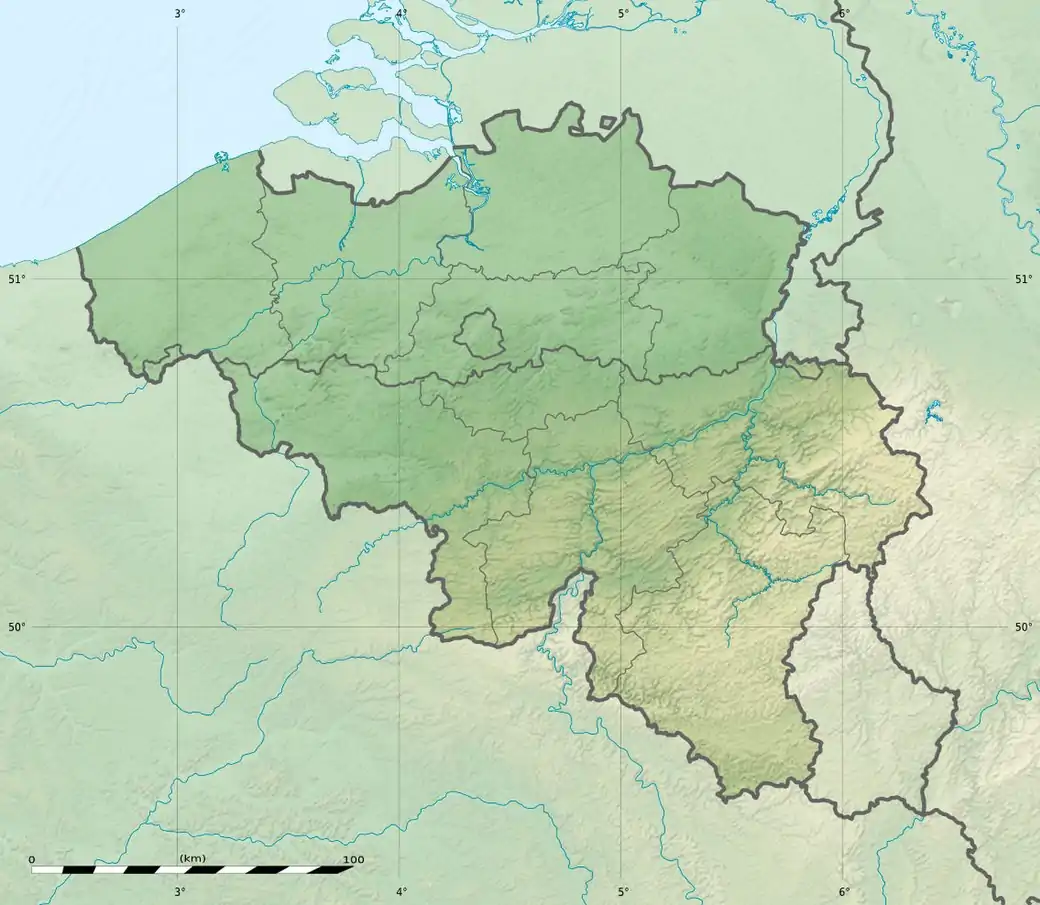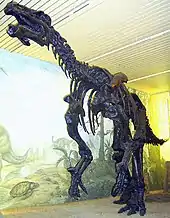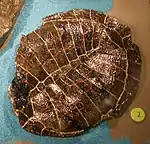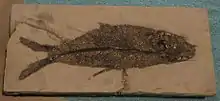Sainte-Barbe Clays Formation
The Sainte-Barbe Clays Formation is a geological formation in Belgium. It is found in localised areas of the northern margin of the Mons Basin, alongside the equivalently aged Hautrage and Baudour Clay Formations.[1] It is Upper Barremian-Lower Aptian in age.[2] It predomiantly consists of laminated clay, with some lignite.[3] It is well known for the "Iguanodon sinkhole" locality near Bernissart where many specimens of Iguanodon bernissartensis were discovered by Louis Dollo in the late 19th century.
| Sainte-Barbe Clays Formation Stratigraphic range: Barremian-early Aptian ~126–124 Ma | |
|---|---|
| Type | Geological formation |
| Underlies | Albian aged "Meules" |
| Overlies | Breccia, Pennsylvanian basement |
| Thickness | Variable, 50 m (160 ft) at Bernissart |
| Lithology | |
| Primary | Clay |
| Other | Lignite |
| Location | |
| Coordinates | 50.5°N 3.6°E |
| Approximate paleocoordinates | 40.7°N 13.7°E |
| Country | |
| Extent | Localised within the northern margins of the Mons Basin |
 Sainte-Barbe Clays Formation (Belgium) | |
Geologic context
The Sainte-Barbe Clays Formation are part of the stratigraphy of the Mons Basin, a Cretaceous-Cenozoic sedimentary basin in western Belgium. The subsidence of the basin floor is caused by the dissolution of anhydrite in the Carboniferous basement. Wealden facies are the oldest units within the basin, and are only found on the northern margin of the basin, being absent from the central and southern parts of the basin. Localised areas of significant subsidence, referred to as "sinkholes" are observed. The Wealden facies are overlain by "mixed siliciclastic–carbonate formations" called Meules dating to the Albian.[1]
Fossil content
Tetrapods
| Tetrapods of the Sainte-Barbe Clays Formation | ||||||
|---|---|---|---|---|---|---|
| Genus | Species | Location | Stratigraphic position | Abundance | Notes | Images |
| Anteophthalmosuchus | A. epikrator[4] | Bernissart | "Two ... fully articulated skeletons, one missing the skull and mandible."[5] | Goniopholidid crocodyliform | ||
| Bernissartia | B. fagesii | IRSNB R46, mostly complete skeleton | Bernissartiid crocodyliform |  | ||
| Chitracephalus | C. dumonii | Carapace with preserved limbs | Cryptodiran turtle[6] | |||
| Iguanodon | I. bernissartensis | Multiple skeletons | Iguanodontian dinosaur |  | ||
| Mantellisaurus | M. atherfieldensis | IRSNB 1551, single mostly complete skeleton | Iguanodontian dinosaur, formerly considered holotype of "Dollodon bampingi"[7] |  | ||
| Hylaeobatrachus | H. croyii | Slab and counterslab of a complete skeleton | Salamander |  | ||
| Peltochelys | P. duchastelii | Shell fragments | Paracryptodire, probable close relative of Compsemys[8] |  | ||
| Theropoda | Indeterminate | Phalanx | ||||
Fish
| Fish of the Sainte-Barbe Clays Formation | ||||||
|---|---|---|---|---|---|---|
| Genus | Species | Location | Stratigraphic position | Abundance | Notes | Images |
| Aethalionopsis | A. robustus | Bernissart | Formerly referred to Anaethalion |  | ||
| Amiopsis | A. dolloi |  | ||||
| Barbalepis | B. macroptera | Formerly referred to Coccolepis[9] | ||||
| Callopterus | C. insignis |  | ||||
| Pattersonella | P. formosa | Formerly referred to Leptolepis |  | |||
| Scheenstia | S. bernissartensis | Multiple specimens | Previously referred to Lepidotes, L. brevifulcratus is a junior synonym.[10] |  | ||
- Other fish
Insects
The Tettigarctid cicada Hylaeoneura lignei is known from the formation.[14]
Flora
- Alethopteris elegans[12]
- Cladophlebis dunkeri[11]
- Conites minuta[11]
- Laccopteris dunkeri[11]
- Leckenbya valdensis[11]
- Matonidium goepperti[11]
- Onychiopsis mantelli[11]
- Pecopteris conybeari[12]
- P. polymorpha[12]
- Pinites solmsi[11]
- Polypodites mantelli[12]
- Ruffordia goepperti[11]
- Sagenopteris mantelli[11]
- Sphenopteris delicatissima[11]
- S. fittoni[11]
- S. roemeri[12]
- Stellatopollis hughesii[16]
- Weichselia mantelli[11]
- Adiantites sp.[11]
- Equisetites sp.[11]
- Gleichenia sp.[17]
- Gleichenites sp.[17]
- Hausmannia (Protorhipis)[11]
- Lycopodites sp.[11]
- cf. Taeniopteris sp.[11]
Ichnofossils
- Algites sp.[11]
References
- Godefroit, Pascal (2012). "A Short Introduction to the Geology of the Mons Basin and the Iguanodon Sinkhole, Belgium". Bernissart dinosaurs and early Cretaceous terrestrial ecosystems. Indiana University Press. pp. 35–42. ISBN 978-0-253-35721-2. OCLC 721905743.
- Dejax, J.; Pons, D.; Yans, J. (April 2007). "Palynology of the dinosaur-bearing Wealden facies in the natural pit of Bernissart (Belgium)". Review of Palaeobotany and Palynology. 144 (1–2): 25–38. doi:10.1016/j.revpalbo.2005.10.004.
- Schnyder, Johann; Dejax, Jean; Keppens, Edward; Nguyen Tu, Thanh Thuy; Spagna, Paul; Boulila, Slah; Galbrun, Bruno; Riboulleau, Armelle; Tshibangu, Jean-Pierre; Yans, Johan (October 2009). "An Early Cretaceous lacustrine record: Organic matter and organic carbon isotopes at Bernissart (Mons Basin, Belgium)". Palaeogeography, Palaeoclimatology, Palaeoecology. 281 (1–2): 79–91. doi:10.1016/j.palaeo.2009.07.014.
- Ristevski, Jorgo; Young, Mark T.; de Andrade, Marco Brandalise; Hastings, Alexander K. (April 2018). "A new species of Anteophthalmosuchus (Crocodylomorpha, Goniopholididae) from the Lower Cretaceous of the Isle of Wight, United Kingdom, and a review of the genus". Cretaceous Research. 84: 340–383. doi:10.1016/j.cretres.2017.11.008.
- Martin, Jeremy E.; Delfino, Massimo; Smith, Thierry (2016-11-01). "Osteology and affinities of Dollo's goniopholidid (Mesoeucrocodylia) from the Early Cretaceous of Bernissart, Belgium". Journal of Vertebrate Paleontology. 36 (6): e1222534. doi:10.1080/02724634.2016.1222534. ISSN 0272-4634.
- Pérez-García, Adán (September 2012). "The European Early Cretaceous Cryptodiran Turtle Chitracephalus dumonii and the Diversity of a Poorly Known Lineage of Turtles". Acta Palaeontologica Polonica. 57 (3): 575–588. doi:10.4202/app.2011.0065. ISSN 0567-7920.
- McDonald, Andrew T. (February 2012). "The status of Dollodon and other basal iguanodonts (Dinosauria: Ornithischia) from the Lower Cretaceous of Europe". Cretaceous Research. 33 (1): 1–6. doi:10.1016/j.cretres.2011.03.002.
- Joyce, Walter G.; Rollot, Yann (2020-05-14). "An alternative interpretation of Peltochelys duchastelii as a paracryptodire". Fossil Record. 23 (1): 83–93. doi:10.5194/fr-23-83-2020. ISSN 2193-0074.
- Olive, Sébastien; Taverne, Louis; López-Arbarello, Adriana (March 2019). "A new genus of coccolepidid actinopterygian from the Cretaceous Iguanodon-bearing locality of Bernissart, Belgium". Cretaceous Research. 95: 318–335. doi:10.1016/j.cretres.2018.11.020.
- Cavin, Lionel; Deesri, Uthumporn; Olive, Sébastien (2020-03-18). "Scheenstia bernissartensis (Actinopterygii: Ginglymodi) from the Early Cretaceous of Bernissart, Belgium, with an appraisal of ginglymodian evolutionary history". Journal of Systematic Palaeontology. 18 (6): 513–527. doi:10.1080/14772019.2019.1634649. ISSN 1477-2019.
- Quinet, 1969
- Dupont, 1892
- du Pauw, 1902
- Lameere & Severin, 1897
- Poinar & Boucot, 2006
- Yans et al., 2006
- Woodward, 1885
Bibliography
- Poinar, G., and A. J. Boucot. 2006. Evidence of intestinal parasites of dinosaurs. Parasitology 133. 245–249.
- Yans, J.; J. Dejax; D. Pons; L. Taverne, and P. Bultynck. 2006. The iguanodons of Bernissart (Belgium) are middle Barremian to earliest Aptian in age. Bulletin de l'Institut Royal des Sciences Naturelles de Belgique, Science de la Terre 76. 91–95.
- Quinet, G.-E. 1969. Bernissart...il y a 125.000.000 d'Années. Le Règne des Iguanodons - Bernissart...125,000,000 Years Ago. The Reign of the Iguanodon, 1–86. ..
- du Pauw, L. F. 1902. Notes sur les Fouilles du Charbonnage de Bernissart. Découverte, Solidification et Montage des Iguanodons - Notes on the excavations of the Bernissart coal mine. Discovery, solidification, and mounting of the Iguanodons, 1–25. ..
- Lameere, A., and G. Severin. 1897. Les insectes de Bernissart. Annales de la Société Entomologique de Belgique 41. 35–38.
- Dupont, É. 1892. Le gisement des Iguanodons de Bernissart - The locality of the Iguanodons of Bernissart. Bulletin de la Société Belge de Géologie, de Paléontologie et d'Hydrologie 6. 86–92.
- Woodward, H. 1885. On Iguanodon mantelli, Meyer. Geological Magazine, decade 3 2. 10–15.
Further reading
- P.-J. Van Beneden. 1878. Sur la découverte de reptiles fossiles gigantesques dans le charbonnage de Bernissart près de Péruwelz [On the discovery of gigantic fossil reptiles in the Bernissart coal mine near Péruwelz]. Bulletin de l'Academie Royale des Sciences, des Lettres et des Beaux-Arts de Belgique, série 2 45:578-579
